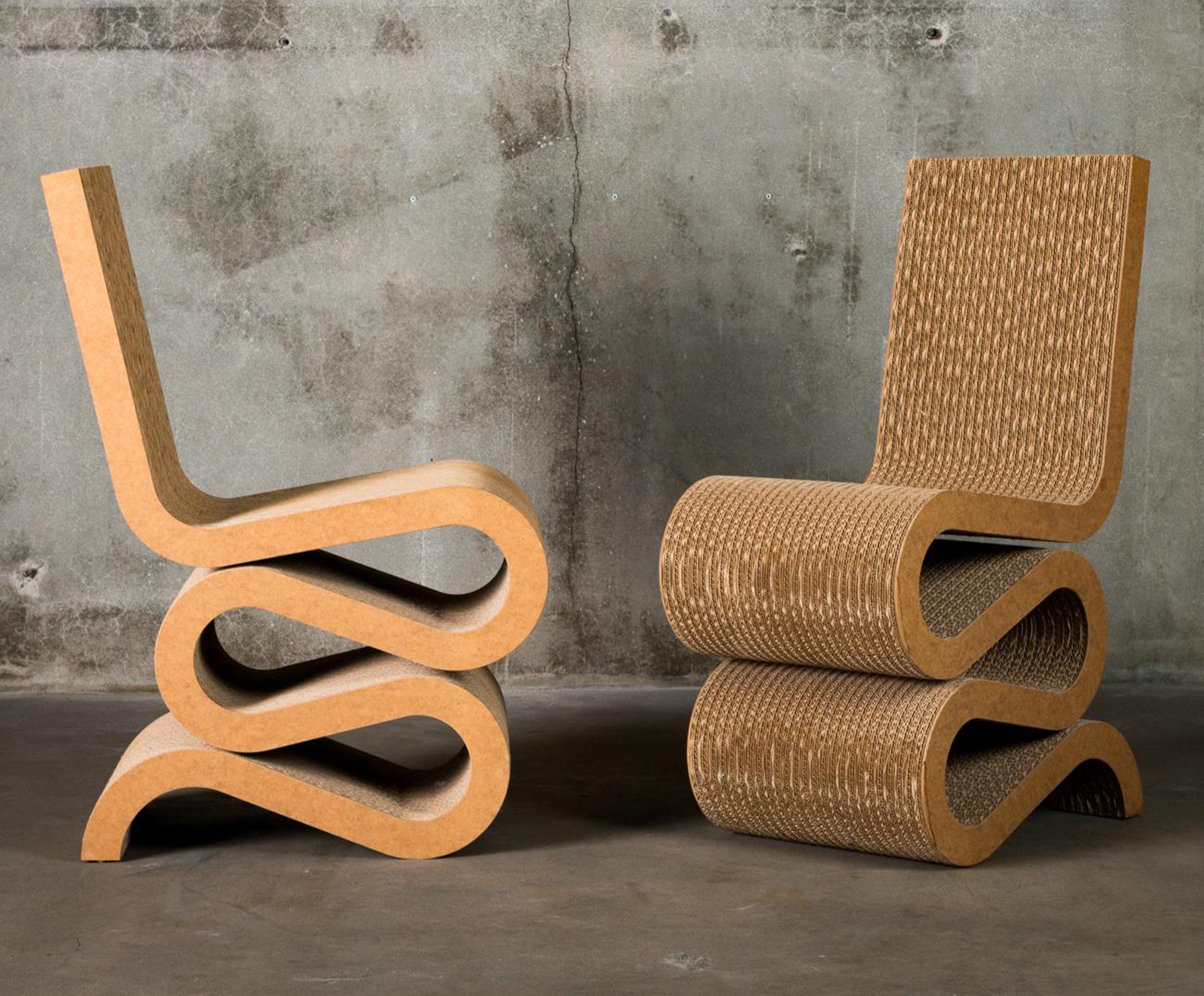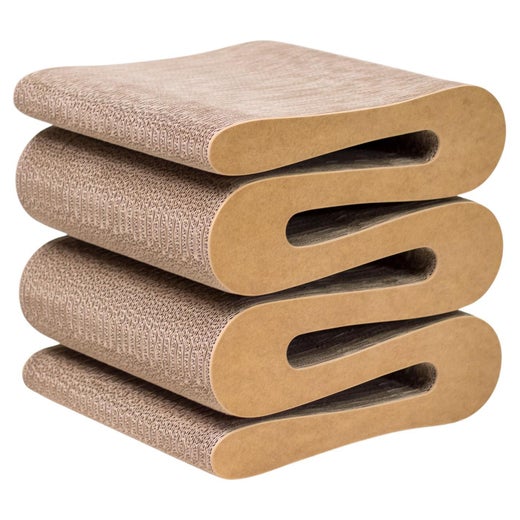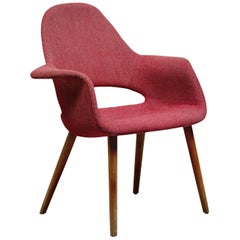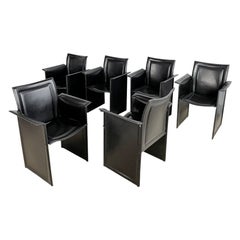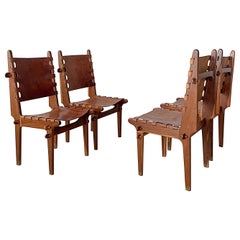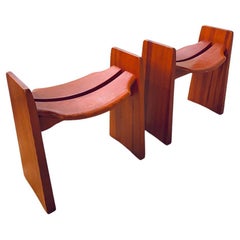Frank O. Gehry Easy Edges "Wiggle" Chairs, 1980s, USA
About the Item
- Creator:Frank Gehry (Designer)
- Design:
- Dimensions:Height: 35 in (88.9 cm)Width: 14 in (35.56 cm)Depth: 24 in (60.96 cm)Seat Height: 17 in (43.18 cm)
- Sold As:Set of 2
- Style:Post-Modern (Of the Period)
- Materials and Techniques:Masonite,Laminated
- Place of Origin:
- Period:1980-1989
- Date of Manufacture:1980s
- Condition:
- Seller Location:Biebergemund, DE
- Reference Number:1stDibs: LU3114320738052
Wiggle Chair
In April of 1972, the New York Times Magazine heralded the introduction of what it dubbed “Paper Furniture for Penny Pinchers.” In his recently launched studio, Canadian-American architect Frank Gehry (b. 1929) had invented a new kind of furniture from the cardboard used to make architectural models. The venturesome, sculptural line included the Wiggle chair.
“If the cost of living keeps rising, we may all be taking a fresh look at paper furniture,” pronounced the magazine. “If it's as fanciful and visually exciting as this collection designed by Los Angeles architect Frank Gehry and constructed from laminated cardboard, the prospects aren't that bleak.”
Indeed, Gehry’s paper furniture series, Easy Edges, was captivating for the dynamic, sinuous forms he managed to tease from a material as bland as packaging cardboard. The collection’s signature Wiggle chair, for example, resembles a gently unfurling ribbon, its graceful S-shape a striking foil to the rough quality of its material.
An alternative to plastic as well as an antidote to what Gehry considered “ponderous, overpriced and tyrannical” furniture of the time, the Easy Edges series was ingeniously simple in form and production. At launch, the Wiggle chair was priced at under $30, prompting some to characterize it as disposable furniture.
That designation may not be the most apt, however. Despite the lowbrow nature of its material, the Wiggle chair is impressively durable as well as comfortable, a result achieved by carefully calculated corrugation. Alternating the direction of corrugation in each of the chair’s layers gave it “enough strength to support a small car,” Gehry told The Christian Science Monitor in 1972.
Another benefit to the stacked layers of cardboard? A noise-absorbing quality that made the Wiggle a practical seat for family homes — although the chair is now more likely to serve as a statement piece in a modern interior than as a set around a dining table.
Despite the immediate popularity of the Easy Edges furniture, Gehry stopped producing the line out of his own office in the early 1980s in order to focus on his primary passion: architecture. But Swiss manufacturer Vitra — for which Gehry would go on to design a headquarters and a design museum in Weil am Rhein, Germany — obtained the rights for the collection and has been manufacturing the Wiggle chair and its coordinating Wiggle stool ever since.
Frank Gehry
With magnificent buildings such as the Guggenheim Bilbao, Disney Concert Hall in Los Angeles and the new Foundation Louis Vuitton in Paris, Frank Gehry has changed the nature and spirit of contemporary architecture. Yet the world’s best-known living architect has also enjoyed a prolific career as a designer of artful and functional objects, ranging from furniture to jewelry, that even at smaller scale are as lively and captivating as his architectural designs.
Gehry was born in Toronto and moved with his family to Los Angeles in 1947. He received a degree in architecture from the University of Southern California in 1954 and — after several years of casting about that included a stint in the U.S. Army and studies at Harvard — Gehry opened his architectural practice in L.A. in 1962.
Idiosyncratic renovations to his small, traditional house in Santa Monica — such as cladding portions of the exterior in chain-link fencing and corrugated metal — drew attention to Gehry in architectural circles. Corporate and institutional commissions added to his reputation, culminating in the global acclaim that greeted the opening of the Guggenheim Bilbao in 1997. But the combination of visual dynamism and structural integrity expressed by that building had been evident for decades in Gehry’s designs. In 1972 he introduced a much-admired line of furniture he called Easy Edges. The curves and flowing lines of the pieces, which include the Wiggle chair, seem antithetical to the material are made from: cardboard — a presumably flimsy material that, when stacked, laminated and folded, is actually extraordinarily sturdy.
Many of Gehry’s designs feature an abstracted fish motif. For the architect, it is a symbol of vitality, strength and flexibility. The fish appears in a group of 1982 plastic lamps created for Formica (and exhibited by the Jewish Museum in New York in 2010). Gehry used the motif in crystal goblets for Swid Powell (1990), his Pito kettle for Alessi (1992) and as earrings for a 2006 jewelry collection for Tiffany that also includes torqued rings, necklaces and bangles.
Gehry returned to furniture design in 1992 with a remarkably energetic line of furniture for Knoll with frames and seating made of bent, lightweight wooden strops. (The pieces' names, such as Power Play and Cross Check, derive from ice hockey.) In 2004, Heller released a group of twisted, faceted furnishings in molded polyethylene meant to evoke Gehry’s architecture. But — whether its tableware, jewelry or furniture — all Gehry’s designs do that--sharing an animated aesthetic built on a solid foundational core. To possess a piece of Gehry design is to own one of his buildings, in miniature.
Find vintage Frank Gehry chairs, tables and other furniture on 1stDibs.
You May Also Like
21st Century and Contemporary American Mid-Century Modern Stools
Other
Vintage 1970s American Mid-Century Modern Stools
Papercord, Masonite
Vintage 1970s Mid-Century Modern Chairs
Paper
Mid-20th Century American Mid-Century Modern Chairs
Masonite, Paper
Vintage 1970s Mid-Century Modern Chairs
Masonite, Paper
Vintage 1980s Canadian Post-Modern Chairs
Plywood, Paper
Late 20th Century Modern Side Chairs
Paper
20th Century Modern Side Chairs
Maple, Bentwood, Plywood
Vintage 1970s Mid-Century Modern Lounge Chairs
Masonite, Paper
Early 2000s American Modern Side Chairs
Aluminum
More From This Seller
View AllVintage 1950s American Mid-Century Modern Side Chairs
Fabric, Plywood
Vintage 1980s Italian Post-Modern Side Chairs
Leather
Vintage 1960s Ecuadorean Brutalist Dining Room Chairs
Leather, Teak
Vintage 1970s Swedish Mid-Century Modern Stools
Pine
Mid-20th Century German Mid-Century Modern Stools
Oak
Mid-20th Century Austrian Mid-Century Modern Coffee and Cocktail Tables
Metal
Recently Viewed
View AllRead More
Five of Our Favorite Pieces From the Cooper Hewitt’s Storage
The off-site collection comprises more than 215,000 pieces.
These New York Architects Love a Complicated Project
From Brooklyn townhouses to Maine campgrounds, Trattie Davies and Jonathan Toews relish a challenge, like transforming a former warehouse space into the new 1stdibs Gallery.
